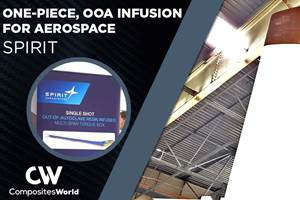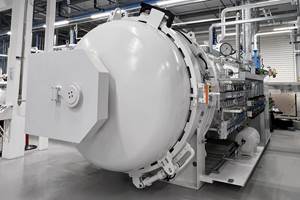NASA to build biggest composite rocket parts ever made
The robotic system is part of the Composites Technology Center at NASA’s Marshall Space Flight Center in Huntsville, AL.
One of the largest composites manufacturing robots created in America will help NASA build the biggest, lightweight composite parts ever made for space vehicles. The robot resides at NASA's Marshall Space Flight Center in Huntsville.
“Marshall has been investing in composites for a long time,” said Preston Jones, deputy director of Marshall’s Engineering Directorate. “This addition to Marshall’s Composites Technology Center provides modern technology to develop low-cost and high-speed manufacturing processes for making large composite rocket structures. We will build and test these structures to determine if they are a good fit for space vehicles that will carry humans on exploration missions to Mars and other places.”
NASA’s new Space Launch System required plenty of different materials. Lightweight composites have the potential to increase the amount of payload that can be carried by a rocket along with lowering its total production cost. NASA is conducting composites manufacturing technology development and demonstration projects to determine whether composites can be part of the evolved Space Launch System and other exploration spacecraft, such as landers, rovers and habitats.
“The robot will build structures larger than 8 meters, or 26 feet, in diameter, some of the largest composite structures ever constructed for space vehicles, “said Justin Jackson, the Marshall materials engineer who installed and checked out the robot and who helped build and test one of the largest composite rocket fuel tanks ever made. “Composite manufacturing has advanced tremendously in the last few years, and NASA is using this industrial automated fiber placement tool in new ways to advance space exploration. Marshall's investment in this robot will help mature composites manufacturing technology that may lead to more affordable space vehicles."
The robot is mounted on a 40-foot-long track in Marshall’s Composites Technology Center that is part of NASA’s National Center for Advanced Manufacturing. This center already has support infrastructure necessary for composite manufacturing: large autoclaves, curing chambers, test facilities and digital analysis systems.
To make large composite structures, the robot travels on a track, and a head at the end of its 21-foot robot arm articulates in multiple directions. The head can hold up to 16 spools of carbon fibers that look like pieces of tape and are as thin as human hairs. The robot places the fibers onto a tooling surface in precise patterns to form different large structures of varying shapes and sizes. In what looks like an elaborate dance, according to NASA, the tooling surface holds the piece on a rotisserie-like system on a parallel track next to the robot. The robot head can be changed for different projects, which makes the system flexible and usable for various types of manufacturing.
The first project that the robot will tackle is making large composite structures for a Technology Demonstration Mission (TDM) program managed by Marshall for the Space Technology Mission Directorate. For the project, engineers will design, build, test and address flight certification of large composite structures similar to those that might be infused into upgrades for an evolved Space Launch System.
The large structures built by the robot will be tested in nearby Marshall structural test stands where spaceflight conditions can be simulated.
"Composite materials are used across NASA projects for everything from aircraft to human space vehicles to planetary probes," said Larry Pelham, a Marshall composites expert who is leading manufacturing operations with the robot. “Robotic systems allow NASA to support a variety of research and development from low technology readiness levels to high technology readiness levels where structures are ready for flight tests."
NASA is a partner in the National/Interagency Advanced Manufacturing Initiative and will share its data with American companies to open up the marketplace for increased use of composites across a number of industries.
Related Content
Plataine unveils AI-based autoclave scheduling optimization tool
The Autoclave Scheduler is designed to increase autoclave throughput, save operational costs and energy, and contribute to sustainable composite manufacturing.
Read MoreVIDEO: One-Piece, OOA Infusion for Aerospace Composites
Tier-1 aerostructures manufacturer Spirit AeroSystems developed an out-of-autoclave (OOA), one-shot resin infusion process to reduce weight, labor and fasteners for a multi-spar aircraft torque box.
Read MoreComposites manufacturing for general aviation aircraft
General aviation, certified and experimental, has increasingly embraced composites over the decades, a path further driven by leveraged innovation in materials and processes and the evolving AAM market.
Read MoreBusch expands autoclave solutions
Busch announces its ability to address all autoclave, oven and associated composites manufacturing requirements following the acquisition of Vacuum Furnace Engineering.
Read MoreRead Next
Developing bonded composite repair for ships, offshore units
Bureau Veritas and industry partners issue guidelines and pave the way for certification via StrengthBond Offshore project.
Read MorePlant tour: Daher Shap’in TechCenter and composites production plant, Saint-Aignan-de-Grandlieu, France
Co-located R&D and production advance OOA thermosets, thermoplastics, welding, recycling and digital technologies for faster processing and certification of lighter, more sustainable composites.
Read More“Structured air” TPS safeguards composite structures
Powered by an 85% air/15% pure polyimide aerogel, Blueshift’s novel material system protects structures during transient thermal events from -200°C to beyond 2400°C for rockets, battery boxes and more.
Read More


























